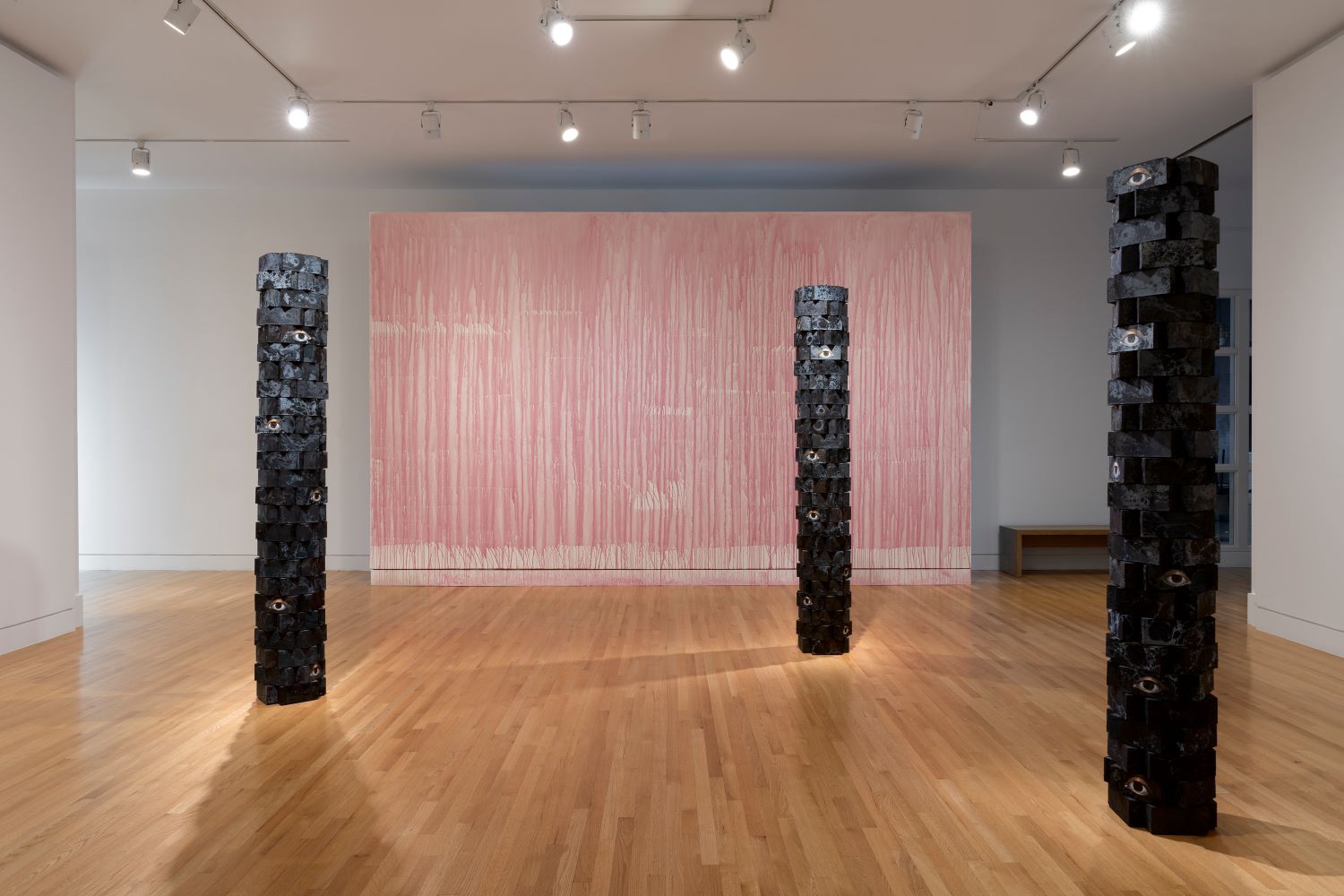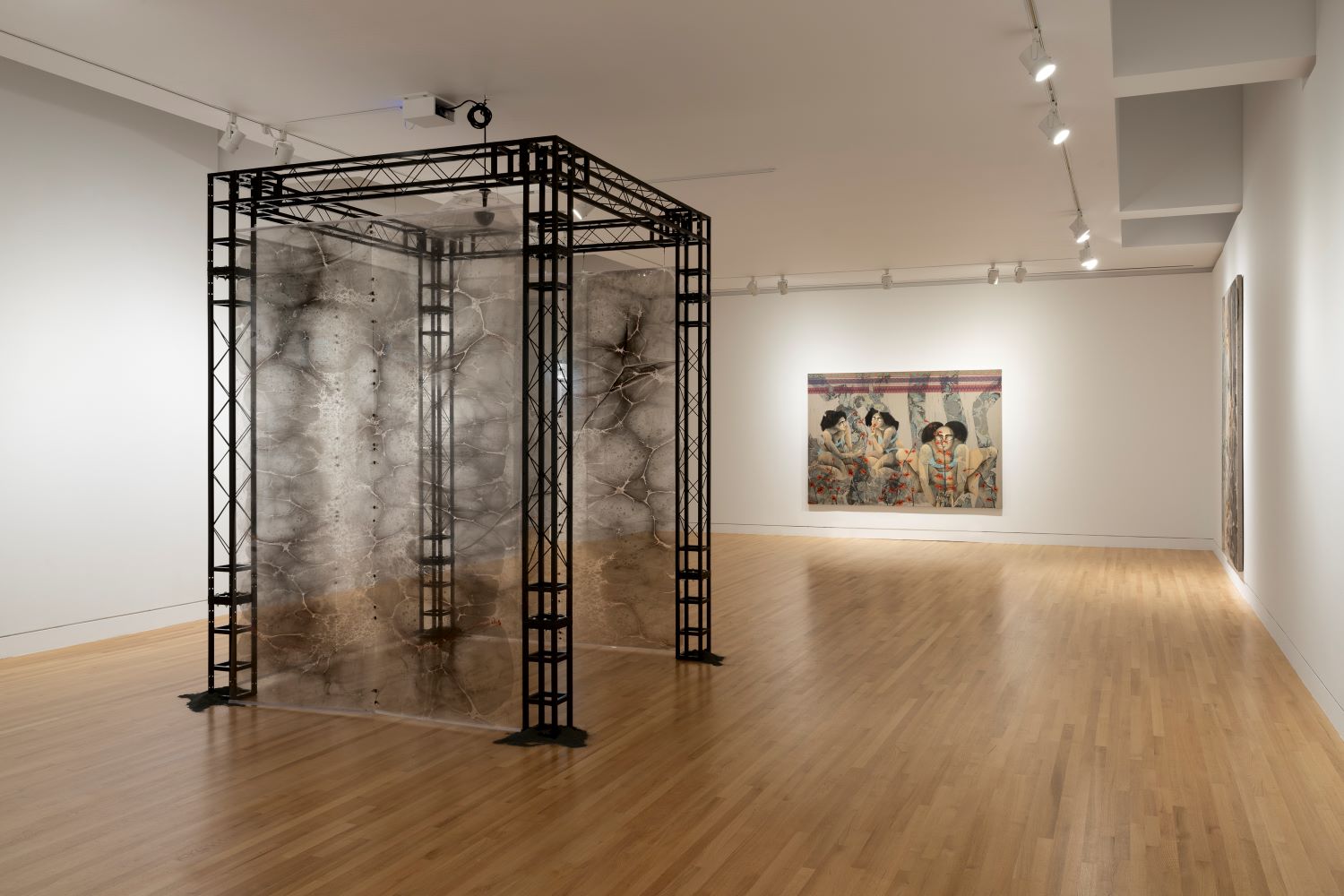Frye Favorites is a series in which members of the Frye’s staff and community share their perspectives on memorable exhibitions and works from the museum’s collection. This post features Sarah Bloom, Senior Communications Officer, Exhibitions, Interpretation, and Youth Programs at the Gates Foundation Discovery Center. Bloom reflects on Torshi (2024), a favorite work from exhibition Hayv Kahraman: Look Me in the Eyes, which is on view from October 5, 2024–February 2, 2025.

Installation view of Hayv Kahraman: Look Me in the Eyes, Frye Art Museum, Seattle, October 5, 2024–February 2, 2025. Photo: Jueqian Fang
“When I saw Torshi at the exhibition’s opening, I learned about Kahraman’s process of making it. As I heard about the way she painted the wall using fermented beet juice, and the smell that filled the gallery as she was installing the work, the first thing I thought of was ful madams (fava bean stew). In Egypt, where I was born, the pickled vegetables of torshi are essential in so many dishes, but they're never the main focus. They're not really eaten by themselves. When I think about specific foods that are central to my immigrant experience, I don't think of the pickled vegetables. In Egypt we have another word–mekhalel, which means foods and vinegar, such as vinegared vegetables ('torshi' is really a Persian word). And ful madams came to mind for me, as one of the most essential Egyptian foods that I grew up with. You would never eat ful madams without some kind of torshi or pickled vegetables.
To me, the accompanying elements to a main dish are really the glue that preserves the memories of those foods. I think it’s one of the most unique things that you can eat, in terms of a regional or cultural dish. But at the same time, it isn't really something that people talk about as often. I know that, for example, kimchi has become very more well-known, as a Korean food that Americans are generally more familiar with. I don't think torshi has broken into the American mainstream in the same way. A lot of times when people here eat Middle Eastern pickles, they don't know what they are.
In Egypt, we eat something called left, which is pickled turnips with a little bit of beet juice added, to turn them red. Anytime you go to a Middle Eastern restaurant and you're eating red pickles, they're probably turnips tinted with beet juice. They’re kind of sweet, you don't always know exactly what they are—but they are just the most perfect accompaniment to any dish you could eat in Egyptian cooking. When I encountered Kahraman’s Torshi installation, I started to think about how, in dishes like pickled beets, you’re preserving these foods and preserving your culture through these foods. But, by submerging them in vinegar and putting them in a jar, you're also changing the original vegetables; you're changing their nature.
Kahraman often talks about duality in her work, which is something I connect with. When you’ve moved to a different country and culture from where you were raised, I feel there is an element of holding on, but also inevitably of never being able to fully retain who you once were. The immigrant experience is transformational; you’re both navigating who you were and inevitably changing as a person into someone else. And there's a resistance in between the two. I don't like the word 'reject,' because I don't really necessarily reject. I think it's more about finding the right balance between adaptation and transformation of the self through the immigrant experience.
Time is the other thing that I thought a lot about standing in front of Torshi. The desire to really slow down and be present feels very non-Western, especially in this day and age of speed and efficiency. When I consider all the foods that the artwork evokes for me, many are labor-intensive, in terms of their preparations. The process of making is very integral to conjuring a sense of rootedness and belonging within myself. More so than even the experience of eating, that intentional effort is critical in preserving the key pieces of my cultural identity, especially as I think about the process of making in connection with food and the way it revives memories of family and place.
Kahraman talks about certain parts of her memories that are somewhat blank. And I feel I have that experience too, from my childhood. When I take the time to make a more complicated dish that I know requires all of these steps, and the time, and the smells, and the process, I start getting flashes of those forgotten moments from my past. This has become especially true as I get older and further away from the places where I grew up and the family that was around me then and those who are not here anymore.
As a curator, I also think about this work in terms of its storytelling. I'm really cognizant that every person has a unique story. Even if it can seem as though a similar experience is happening to multiple people, every person processes and transforms experiences in their own way. I didn't have the same journey, obviously, as Kahraman. I came from very different country, for very different reasons, but I immigrated around the same age she did. When you go through a period of transformation or change, through leaving someplace and learning to live in a new place, it impacts you in a real way. At the same time, I know my immigrant experience is very different than my mother's immigrant experience, even though we both came to the U.S. at the same time. Listening to Kahraman talk about her mom and reference her mom through the recording of her voice in the artwork Sizar (2023/2024) made me think about this. I felt like she was referencing her mom's experience, and her humanity, in contrast to Hayv’s own experience.

Hayv Kahraman. From left: Sizar, 2023/2024. Audio recording (21:33 min.), metal, mylar, silicon carbide. Lip Plants, 2023. Oil and acrylic on linen. Courtesy of the artist; Pilar Corrias, London; Jack Shainman Gallery, New York; Vielmetter Los Angeles; and The Third Line, Dubai. Installation view from Hayv Kahraman: Look Me in the Eyes, Frye Art Museum, Seattle, October 5, 2024–February 2, 2025. Photo: Jueqian Fang
In my curatorial work, I try to take myself as much out of the equation as I can, in order to really center others’ voices. I know that many people have made assumptions about me and my story based on the experiences of other folks, whether it's been people from the same part of the world as me, or from the same background, or of the same heritage, or just being immigrants. I've had so many things imposed on me, whether they’ve been stereotypes or expectations or assumptions. As part of my practice working in the arts, I try to listen for the nuance as much as I can. My goal is to bring out that humanity and that uniqueness as I highlight salient issues through exhibition spaces, to really bring them to life. It's so easy to prioritize the problem or the technology. But, for me, the most critical question is: how do we humanize these experiences?”
–Sarah Bloom, Senior Communications Officer, Exhibitions, Interpretation, and Youth Programs, Gates Foundation Discovery Center
(as told to Erin Langner)